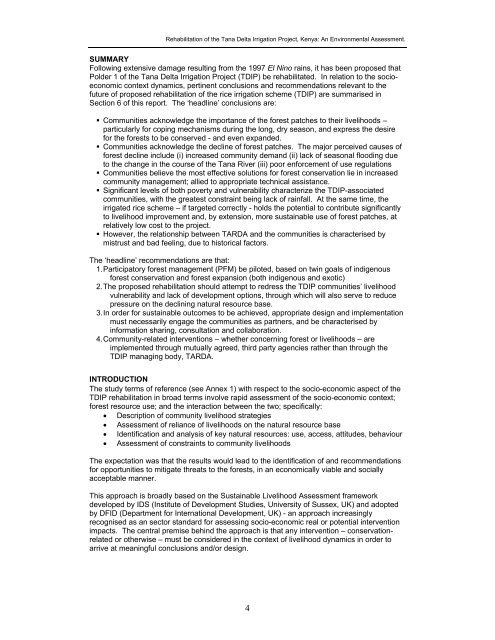Tana Delta Irrigation Project, Kenya: An Environmental Assessment
Tana Delta Irrigation Project, Kenya: An Environmental Assessment
Tana Delta Irrigation Project, Kenya: An Environmental Assessment
Create successful ePaper yourself
Turn your PDF publications into a flip-book with our unique Google optimized e-Paper software.
Rehabilitation of the <strong>Tana</strong> <strong>Delta</strong> <strong>Irrigation</strong> <strong>Project</strong>, <strong>Kenya</strong>: <strong>An</strong> <strong>Environmental</strong> <strong>Assessment</strong>.<br />
SUMMARY<br />
Following extensive damage resulting from the 1997 El Nino rains, it has been proposed that<br />
Polder 1 of the <strong>Tana</strong> <strong>Delta</strong> <strong>Irrigation</strong> <strong>Project</strong> (TDIP) be rehabilitated. In relation to the socioeconomic<br />
context dynamics, pertinent conclusions and recommendations relevant to the<br />
future of proposed rehabilitation of the rice irrigation scheme (TDIP) are summarised in<br />
Section 6 of this report. The ‘headline’ conclusions are:<br />
• Communities acknowledge the importance of the forest patches to their livelihoods –<br />
particularly for coping mechanisms during the long, dry season, and express the desire<br />
for the forests to be conserved - and even expanded.<br />
• Communities acknowledge the decline of forest patches. The major perceived causes of<br />
forest decline include (i) increased community demand (ii) lack of seasonal flooding due<br />
to the change in the course of the <strong>Tana</strong> River (iii) poor enforcement of use regulations<br />
• Communities believe the most effective solutions for forest conservation lie in increased<br />
community management; allied to appropriate technical assistance.<br />
• Significant levels of both poverty and vulnerability characterize the TDIP-associated<br />
communities, with the greatest constraint being lack of rainfall. At the same time, the<br />
irrigated rice scheme – if targeted correctly - holds the potential to contribute significantly<br />
to livelihood improvement and, by extension, more sustainable use of forest patches, at<br />
relatively low cost to the project.<br />
• However, the relationship between TARDA and the communities is characterised by<br />
mistrust and bad feeling, due to historical factors.<br />
The ‘headline’ recommendations are that:<br />
1. Participatory forest management (PFM) be piloted, based on twin goals of indigenous<br />
forest conservation and forest expansion (both indigenous and exotic)<br />
2. The proposed rehabilitation should attempt to redress the TDIP communities’ livelihood<br />
vulnerability and lack of development options, through which will also serve to reduce<br />
pressure on the declining natural resource base.<br />
3. In order for sustainable outcomes to be achieved, appropriate design and implementation<br />
must necessarily engage the communities as partners, and be characterised by<br />
information sharing, consultation and collaboration.<br />
4. Community-related interventions – whether concerning forest or livelihoods – are<br />
implemented through mutually agreed, third party agencies rather than through the<br />
TDIP managing body, TARDA.<br />
INTRODUCTION<br />
The study terms of reference (see <strong>An</strong>nex 1) with respect to the socio-economic aspect of the<br />
TDIP rehabilitation in broad terms involve rapid assessment of the socio-economic context;<br />
forest resource use; and the interaction between the two; specifically:<br />
• Description of community livelihood strategies<br />
• <strong>Assessment</strong> of reliance of livelihoods on the natural resource base<br />
• Identification and analysis of key natural resources: use, access, attitudes, behaviour<br />
• <strong>Assessment</strong> of constraints to community livelihoods<br />
The expectation was that the results would lead to the identification of and recommendations<br />
for opportunities to mitigate threats to the forests, in an economically viable and socially<br />
acceptable manner.<br />
This approach is broadly based on the Sustainable Livelihood <strong>Assessment</strong> framework<br />
developed by IDS (Institute of Development Studies, University of Sussex, UK) and adopted<br />
by DFID (Department for International Development, UK) - an approach increasingly<br />
recognised as an sector standard for assessing socio-economic real or potential intervention<br />
impacts. The central premise behind the approach is that any intervention – conservationrelated<br />
or otherwise – must be considered in the context of livelihood dynamics in order to<br />
arrive at meaningful conclusions and/or design.<br />
4

















